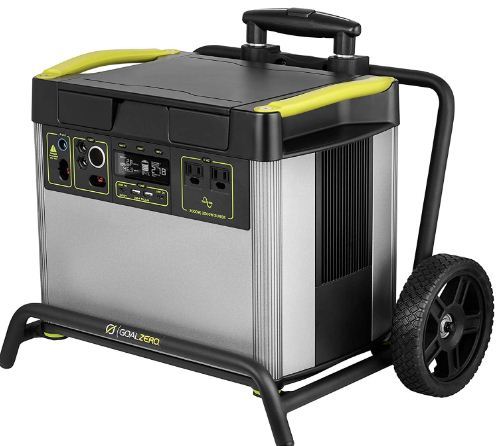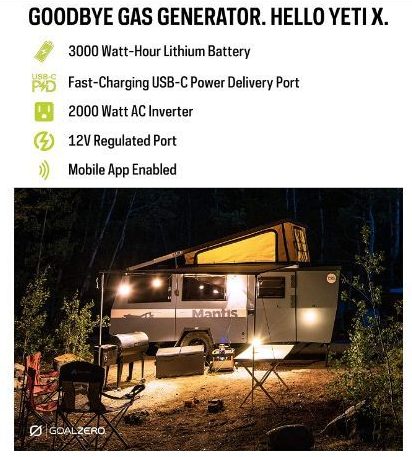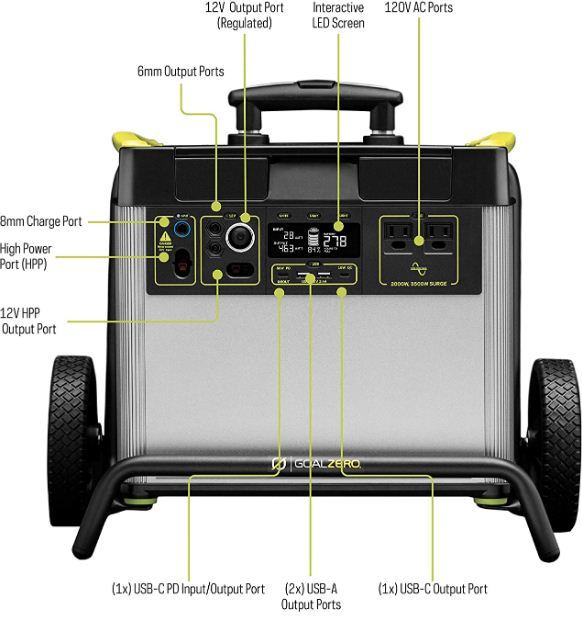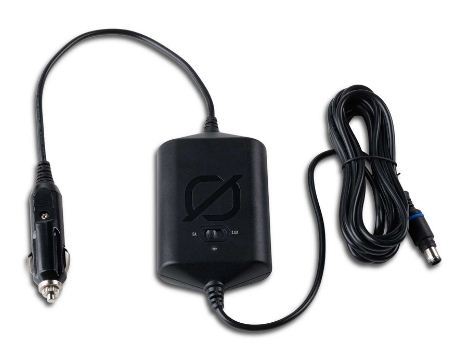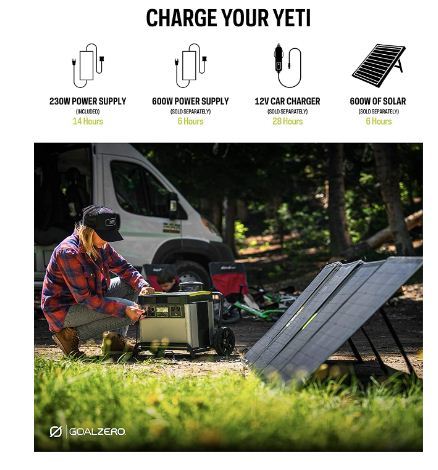In their new Yeti X lineup, the Yeti 3000 portable has been replaced with the new Yeti 3000X. Notable improvements include a higher-output AC inverter, a more efficient MPPT charge controller and a higher solar input limit of 600W for faster solar charging.
The Goal Zero Yeti 3000X is a great choice if you want a portable power station that can power most appliances. The 3000X is perfect for RVs, boats, camping and home backup.
Quick Summary
Generator Applications | |
|---|---|
Off-grid living | + |
Home backup | + |
Large appliances | + |
Small appliances | + |
Camping/outdoors | + |
RV/boating | + |
Cell phones | + |
Features | |
|---|---|
Battery Capacity: | 3032Wh |
Power Output: | USB (4 ports), 12V (3 ports), AC (2 outlets) |
Weight: | 69.7lbs |
Best Features of the Goal Zero Yeti 3000X Portable Power Station
3000Wh Lithium Battery
If you need a solar generator that packs more power, the Yeti 3000X is a great choice. The built-in lithium battery has a 3032Wh capacity, which is more than most portable solar generators.
The high capacity battery makes the 3000X an excellent choice in situations where you need to power appliances for a long time. Think an RV, a boat or at home when there’s a prolonged power outage.
The Yeti 3000X will power a full size fridge for 55 hours, a 42” LED TV for 42 hours and a laptop for 61 hours.
You’ll have to trade off portability for the extra capacity. But this is not an issue if you use the power station at home or in an RV. It’s also not that difficult to handle when driving to campsites.
For easier portability, Goal Zero supplies the Yeti 3000X with a cart.
What Can The Yeti 3000X Power?
Appliance/Device | Approx Runtime/recharges |
|---|---|
Full size refrigerator (200W) | 12.8hrs |
Mini fridge (40W) | 64.4hrs |
CPAP (60W) | 43hrs |
TV (100W) | 25.7hrs |
Microwave (1000W) | 2.5hrs |
Smartphone (12Wh) | 214 recharges |
Laptop (60Wh) | 43 recharges |
Powerful 2000W Inverter
One of the biggest upgrades Goal Zero made to the Yeti 3000X is the AC inverter. The previous Yeti 3000 had a 1500W continuous output and a 3000W surge output.
The new Yeti 3000X has a 2000W continuous output and can handle surge demand of up to 3500W. What this means is that the Yeti 3000X can power larger and power hungrier devices.
You can safely plug in most household appliances including a blender, coffee maker, fridge and TV.
Multiple Output Options
The Yeti 3000X offers three types of outlets: AC, USB and 12V DC.
There are two 120W AC outlets for powering appliances.
Four USB ports let you charge different kinds of devices including a smartphone, drone, camera, tablet and so on. The USB outlets include a pair of 5V USB-A ports, a USB-C PD port with up to 60W output, and a USB-C port with Quick Charge technology.
For power tools, lighting, CPAP and other DC-powered electronics, use one of the three 12V ports. They include a 12V car port with 160W output, a 12V high power port with up to 360W output and a 6mm 12V port with 120W output.
Three Ways to Charge It
The fastest way to recharge the Yeti 3000X is from a wall outlet. Using the included 230W adapter, it takes 14 hours to fill up the 3000Wh battery.
If you spend a lot of time on the road, in a car, truck or RV, you can recharge the 3000X from your car’s 12V socket using the Yeti 12V charging cable (available separately).
And if you are outdoors or during a power outage, you can recharge the Yeti 3000X using solar power. You’ll have to buy a solar panel separately. A 200W solar panel will charge the battery in 18-36 hours.
To make solar charging faster, the 3000X comes with a built-in MPPT charge controller.
Wi-Fi Connectivity
The Yeti 3000X comes with Wi-Fi connectivity, allowing you to monitor and control it from anywhere via the Yeti app.
This includes checking the battery level, selecting power modes and remotely turning individual outlets on and off.
Limitations of the Goal Zero Yeti 3000X
It’s Expensive
Functionally, there really are no serious drawbacks to the Yeti 3000X. It exceeds expectations in all the important areas –power capability, battery capacity, safety, versatility, and portability.
But these great features come at a price. And that’s what we would consider being the main downside of the Goal Zero Yeti 3000X generator; it’s expensive.
The Yeti 3000X costs about $3,000.
But if you want something a bit cheaper, check out our list of the best home backup solar generators. There are still some decent portable power stations that will not break the bank. But most weigh far more, and come with drawbacks.
Slow Charging
All Goal Zero Yeti power stations, not just the 3000X, take their time to recharge. The situation is worse with the Yeti 3000X because of its large capacity.
Compared to many modern solar generators like Bluetti and EcoFlow, 14 hours recharge time is a heck of a long time. Most modern power stations of similar capacity take 2-5 hours to recharge.
Solar recharging is also slow. The 600W max input is too little compared to other power stations with roughly the same capacity.
For instance, the 3600Wh EcoFlow Delta Pro accepts up to 1600W. Even the smaller 2160Wh Jackery Explorer 2000 Pro accepts up to 1400W of solar power.
Goal Zero sells a more powerful 600W AC charger, but even that takes 6 hours to recharge the Yeti 3000X.
Limited Lifespan Battery
The Li-ion NMC battery in the Yeti 3000X is great. It’s lightweight, charges quickly, and lasts longer than lead-acid.
But it’s not the best choice when it comes to longevity. It lasts 500 cycles to 80% capacity while lithium phosphate or LiFEPO4 power stations last over 3000 cycles to 80% capacity.
With frequent use, a Li-ion power station like the Yeti 3000X has a 3-5 year total lifespan. A LiFePO4 power station can last up to 10 years.
Best Alternatives To The Yeti 3000X
Goal Zero Yeti 6000X - More Capacity For Home Backup & Offgrid Power
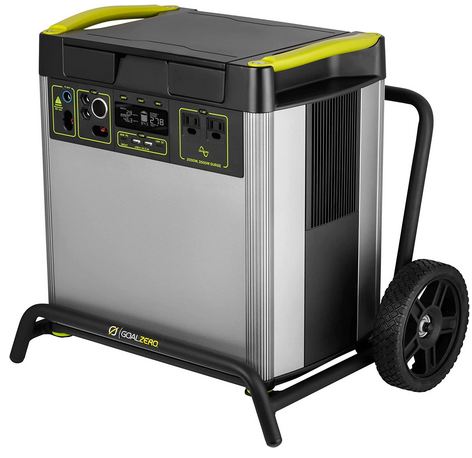
If you need more capacity than the Yeti 3000X offers, consider getting its bigger sibling, the Yeti 6000X. It’s the biggest solar generator Goal Zero currently sells.
The 6000X has twice the capacity at 6,071Wh. This makes it a better pick for home backup or offgrid power in a cabin, RV, or boat.
Power output is the same as the Yeti 3000X at 2000W. You also get the same number and types of outlets and charging methods.
The Yeti 6000X comes with a more powerful 600W AC charger, but it still takes a long time to recharge - 12 hours.
EcoFlow Delta Pro - More Power, Faster Charging & Longer Lasting Battery
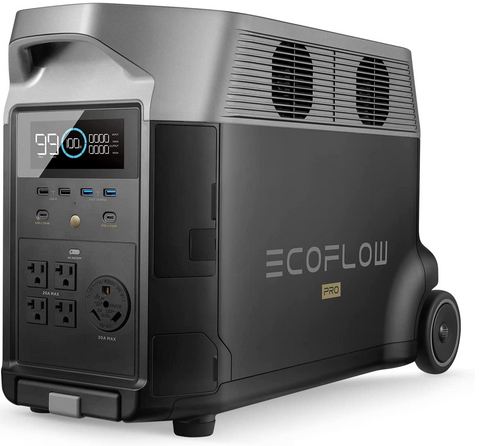
Generally, Goal Zero solar generators are starting to feel a bit dated. Modern power stations like the EcoFlow Delta Pro offer faster charging, a wider variety of outlets, more charging options and other great features.
I also think the Delta Pro is better value for your money compared to the 3000X.
For almost the same price, the Delta Pro has a bigger capacity of 3600Wh and higher power output of 3600W.
You can power multiple appliances for longer with the Delta Pro, making it a better choice than the Yeti 3000X for home backup, RVs, motorhomes, boats, overlanding trucks and off-grid homes.
That’s not all. The Delta Pro has a feature that boosts power output to 4500W. You can also connect two Delta Pros to get 240V 7200W power output.
Despite its large capacity, the EcoFlow Delta Pro has lightning fast charging (which EcoFlow calls X-Stream charging technology). It charges from a wall outlet in just 2.7 hours.
Solar charging is also fast thanks to the higher max solar input of 1800W. You can also charge the Delta Pro from an EV station.
For even faster charging, there’s an option to combine multiple charging methods.
Another big advantage of the Delta Pro over the Yeti 3000X is the type of battery it uses. The LiFePO4 battery makes the Delta Pro heavy (99lbs) but it lasts much longer than Yeti’s Li-ion battery.
It has a cycle life of 3500 cycles to 80% capacity. In other words, the Delta Pro battery stays in top form for years and years, and can last 10 years or more before it’s truly dead.
Jackery Explorer 2000 Pro - Lighter & More Portable
If you want plenty of power and capacity, but prefer something lighter and more portable than the Yeti 3000X (or any of the above two power stations), I recommend the Jackery Explorer 2000 Pro.
Jackery focuses mostly on making solar generators for outdoor enthusiasts. So portability is kinda their thing.
The Jackery 2000 Pro manages to pack a 2160Wh Li-ion battery and a 2200W inverter while keeping the weight at 43lbs.
Now, this is not ultra-light. But it’s a lot more manageable than the Yeti 3000X (69lbs) or the Delta Pro (99lbs). It’s a great pick for truck/car campers, RV owners, and overlanders looking for a solar generator they can move over short distances.
The 2000 Pro has AC, DC, and USB (including 100W USB-C) outputs to support any kind of device or appliance.
Charging speed is pretty good. It accepts a max of 1400W of solar power. Jackery says a 1200W solar kit will charge it in just 2.5 hours.
Ac charging is also fast - it takes just 2 hours to charge from a wall outlet.
Conclusion
The Goal Zero Yeti 3000X lithium generator is a home backup recharging monster. It’s not powerful enough to back up your entire home during an outage, but for a portable solar power station, this is as good as it’s going to get.
The Yeti 3000X can easily power your most important devices and appliances for a couple of days. It’s an awesome solution for family and larger group campers, field workers and those who go on extended off-grid stays.

